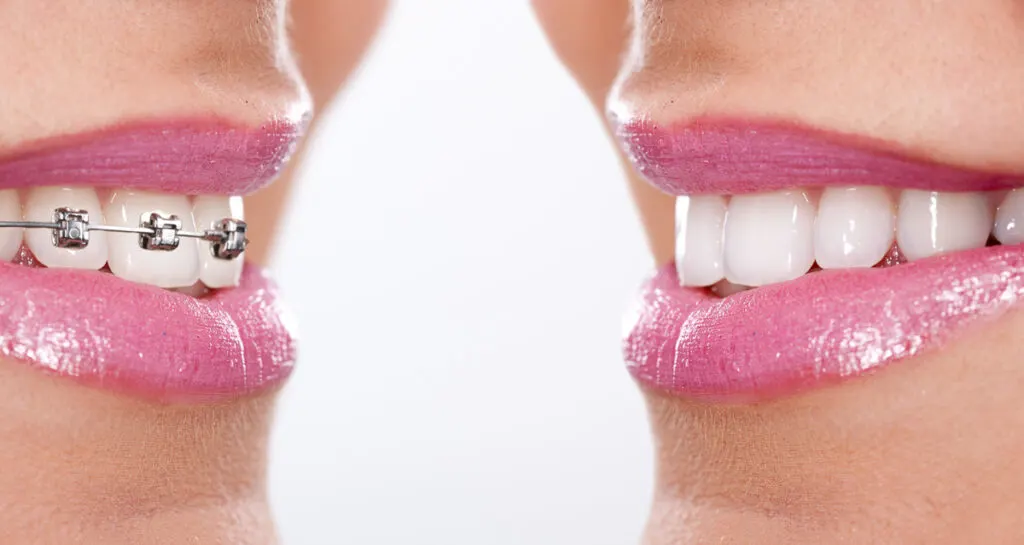Ceramic Braces vs. Metal Braces: What’s the better option? You’ll find the answer and all the relevant information in this article.
Orthodontic treatments offer various options when it comes to straightening your teeth and achieving a beautiful smile.
Two popular choices are ceramic braces and metal braces. Each type has its own set of advantages and considerations.
In this article, we will explore the differences between ceramic braces and metal braces, helping you decide which option suits you best.

Understanding Ceramic Braces
1. Composition and Appearance
Ceramic braces are made from composite materials that are designed to blend in with the natural color of your teeth.
The brackets, which are attached to the front of the teeth, can be tooth-colored or translucent.
Additionally, the archwire connecting the brackets can also be tooth-colored, further enhancing the aesthetic appeal of ceramic braces.
2. Advantages of Ceramic Braces
Ceramic braces offer several advantages. Firstly, they are less noticeable than metal braces, making them popular for individuals who desire a more discreet orthodontic treatment.
Secondly, the composite materials used in ceramic braces are resistant to staining, ensuring that your smile remains vibrant throughout the treatment process.
Lastly, ceramic braces are generally more comfortable than metal braces, as they have smoother edges that are gentle on the gums and cheeks.
3. Disadvantages of Ceramic Braces
While ceramic braces have numerous benefits, they also have a few considerations.
One disadvantage is that they are more brittle than metal braces, making them more prone to breakage or chipping.
Additionally, ceramic braces can be slightly more expensive than their metal counterparts.
Discussing the cost factor with your orthodontist and considering your budget when deciding which option to choose is important.
Exploring Metal Braces
1. Composition and Appearance
Metal braces, also known as traditional braces, are composed of high-grade stainless steel.
The brackets and archwire used in metal braces are typically silver or gray.
2. Advantages of Metal Braces
Metal braces have been the go-to option for many years and offer several advantages. They are highly durable and can withstand the pressure required to move teeth into their correct positions.
Metal braces are also the most cost-effective orthodontic treatment option, making them more accessible to a wider range of individuals.
Additionally, metal braces are known for their versatility in treating even the most complex orthodontic cases.
3. Disadvantages of Metal Braces
One of the primary concerns associated with metal braces is their visibility. Due to their metallic appearance, they can be more noticeable compared to ceramic braces.
This can be a consideration for individuals who prefer a more discreet treatment option.
Furthermore, some people may experience slight discomfort during the initial stages of wearing metal braces due to the friction caused by the brackets and wires.

Factors to Consider When Choosing Between Ceramic and Metal Braces
When deciding between ceramic braces and metal braces, it’s important to consider several factors that can influence your treatment experience and overall satisfaction. Here are some key considerations:
1. Aesthetics
If maintaining a more natural appearance during treatment is important to you, ceramic braces may be the preferred choice.
However, if the visibility of your braces is not a major concern, metal braces offer a highly effective treatment option.
2. Durability and Maintenance
Metal braces are generally more durable and less prone to breakage than ceramic braces.
If you lead an active lifestyle or participate in contact sports, metal braces may be your better option.
On the other hand, if you are careful with your braces and prioritize aesthetics, ceramic braces can be a suitable choice.
3. Treatment Time
The treatment duration can vary depending on the complexity of your orthodontic issues. Metal braces may sometimes provide slightly faster results due to their robust design.
However, the specific treatment time will be determined by your orthodontist based on your unique needs.
4. Affordability
Budget is an important consideration for many individuals. If cost is a significant factor for you, metal braces are generally more affordable than ceramic braces.
However, discussing the financial aspects with your orthodontist and exploring any available payment plans or insurance coverage options is crucial.
5. Oral Hygiene
Maintaining good oral hygiene is essential during orthodontic treatment. Ceramic braces offer an advantage as they are less prone to staining.
However, both ceramic and metal braces require diligent oral care, including regular brushing and flossing, to prevent plaque buildup and maintain optimal oral health.
6. Severity of Orthodontic Issues
The complexity of your orthodontic problems can also influence the choice between ceramic and metal braces.
Metal braces may be recommended for more severe cases requiring significant tooth movement as they offer greater control and durability.
After considering these factors, it is important to consult with your orthodontist, who will thoroughly evaluate your specific needs and help you make an informed decision.
Conclusion on the topic: “Ceramic Braces vs. Metal Braces.”
Choosing between ceramic braces and metal braces is a personal decision that depends on various factors such as aesthetics, durability, treatment time, affordability, oral hygiene, and the severity of your orthodontic issues.
Both options have advantages and considerations, so weighing them carefully is important.
Consulting with an experienced orthodontist will ensure you receive professional guidance tailored to your specific needs, ultimately leading to a beautiful, healthy smile.

FAQs on the topic: “Ceramic Braces vs. Metal Braces”
Are ceramic braces more expensive than metal braces?
Generally, ceramic braces tend to be slightly more expensive than metal braces. However, the cost can vary depending on factors such as your location and the complexity of your orthodontic case.
Do ceramic braces stain easily?
No, ceramic braces are designed to be stain-resistant. However, it’s still important to maintain good oral hygiene and avoid consuming foods and beverages that can cause staining, such as coffee, tea, and red wine.
Can I play sports or musical instruments with ceramic braces?
Yes, you can participate in sports and play musical instruments while wearing ceramic braces. However, wearing a protective mouthguard during contact sports is advisable to prevent any damage to your braces.
Are metal braces more effective than ceramic braces?
The effectiveness of braces depends on the specific orthodontic case and the orthodontist’s expertise. Both ceramic and metal braces can effectively straighten teeth and correct various orthodontic issues.
How often do I need to visit the orthodontist during treatment?
The frequency of orthodontic visits can vary, but typically you will need to visit your orthodontist every 4-8 weeks for adjustments and progress evaluations. Your orthodontist will provide a personalized treatment plan with specific visitation schedules.
- About the Author
- More info

